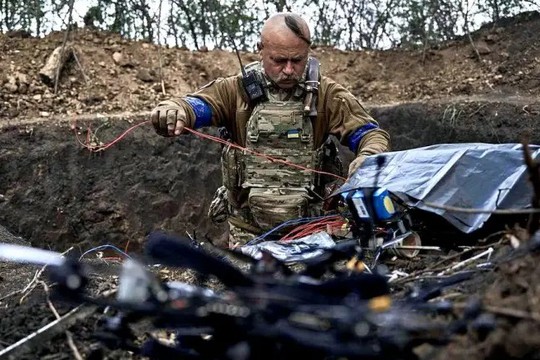A Ukrainian soldier creates an electronic means of combating new Russian weapons.
Photo: AP
Confidential Ukrainian assessments obtained by The Washington Post show how accuracy rates of some Western weapons fell after Russian jamming disrupted guidance systems.
Many U.S.-made satellite-guided munitions in Ukraine have failed to withstand Russian jamming technology, prompting Kyiv to stop using certain types of Western-provided armaments after effectiveness rates plummeted, according to senior Ukrainian military officials and confidential internal Ukrainian assessments obtained by The Washington Post.
Russia’s jamming of the guidance systems of modern Western weapons, including Excalibur GPS-guided artillery shells and the High Mobility Artillery Rocket System, or HIMARS, which can fire some U.S.-made rockets with a range of up to 50 miles, has eroded Ukraine’s ability to defend its territory and has left officials in Kyiv urgently seeking help from the Pentagon to obtain upgrades from arms manufacturers.
Russia’s ability to combat the high-tech munitions has far-reaching implications for Ukraine and its Western supporters — potentially providing a blueprint for adversaries such as China and Iran — and it is a key reason Moscow’s forces have regained the initiative and are advancing on the battlefield.
The success rate for the U.S.-designed Excalibur shells, for example, fell sharply over a period of months — to less than 10 percent hitting their targets — before Ukraine’s military abandoned them last year, according to the confidential Ukrainian assessments.
Six months ago, after Ukrainians reported the problem, Washington simply stopped providing Excalibur shells because of the high failure rate, the Ukrainian officials said, speaking on the condition of anonymity to discuss a sensitive security matter. In other cases, such as aircraft-dropped bombs called JDAMs, the manufacturer provided a patch and Ukraine continues to use them.
The officials agreed to answer questions about the assessments in hopes of drawing attention to the Ukrainian military’s needs. Several Ukrainian and U.S. officials interviewed for this story spoke on the condition of anonymity due to the sensitivity of the issue.
Russia “has continued to expand their use of electronic warfare,” the senior U.S. official said. “And we continue to evolve and make sure that Ukraine has the capabilities they need to be effective.”
U.S.-made guided munitions provided to Ukraine typically were successful when introduced, but often became less so as Russian forces adapted. Now, some arms once considered potent tools no longer provide an edge.
The senior Ukrainian official said Kyiv shared this feedback with Washington but got no response. The Ukrainians have faced a similar challenge with guided 155mm shells provided by other Western countries. Some employ guidance other than GPS, and it is unclear why they also became less effective. U.S. defense officials declined to address the Ukrainian assertion.
Rob Lee, a senior fellow with the Foreign Policy Research Institute, a Philadelphia-based research group, said that Russia’s use of electronic warfare to combat guided munitions was an important battlefield development in the past year.
A web of Russian electronic warfare systems and air defenses menace Ukrainian pilots, the documents said, adding that some Russian jammers also scramble the navigation system of planes. The Russian defense is so dense, the assessment found, that there are “no open windows for the Ukrainian pilots where they feel that they are not at gunpoint.”
HIMARS launchers were celebrated during the first year of Russia’s invasion for their success in striking ammunition depots and command points behind enemy lines.
But by the second year, “everything ended: the Russians deployed electronic warfare, disabled satellite signals, and HIMARS became completely ineffective,” a second senior Ukrainian military official said. “This ineffectiveness led to the point where a very expensive shell was used” increasingly to strike lower-priority targets.
William LaPlante, the Pentagon’s acquisition chief, said last month that an adapted weapon “didn’t work for multiple reasons,” including jamming and other tactical and logistical issues. LaPlante did not disclose which weapon he was referring to.
Senior Ukrainian military officials said Storm Shadow air-launched cruise missiles, provided by Britain, are less susceptible to Russian jamming because they do not rely solely on GPS but two other navigation systems, including an internal map that matches the terrain of its intended flight path. Russian air defenses nonetheless have had some success intercepting them.
“The Russians will learn how to fight it,” the Ukrainian official said.
read more in our Telegram-channel https://t.me/The_International_Affairs

 11:48 27.05.2024 •
11:48 27.05.2024 •























